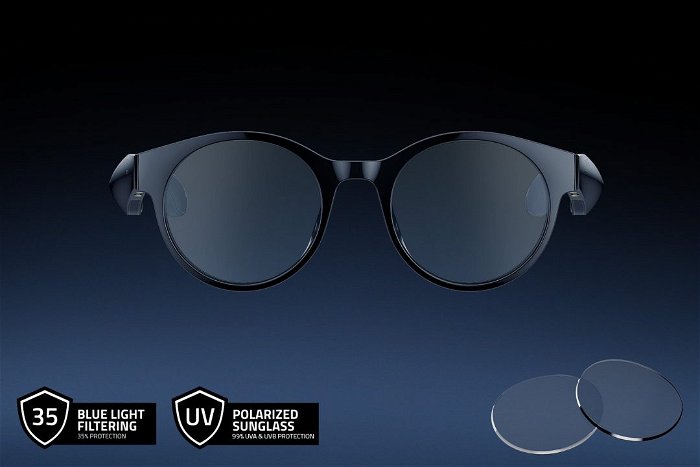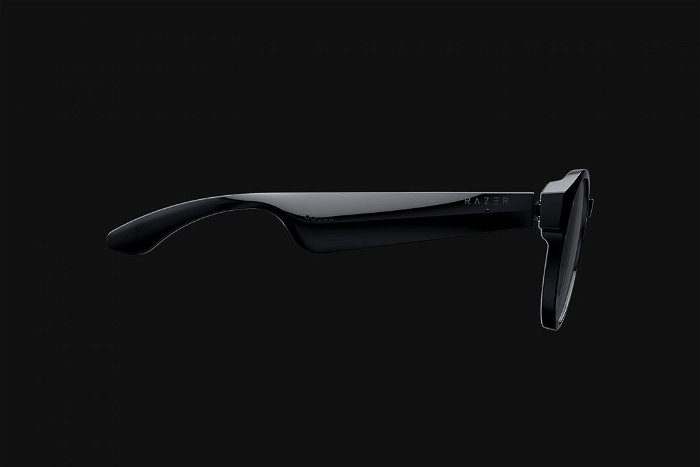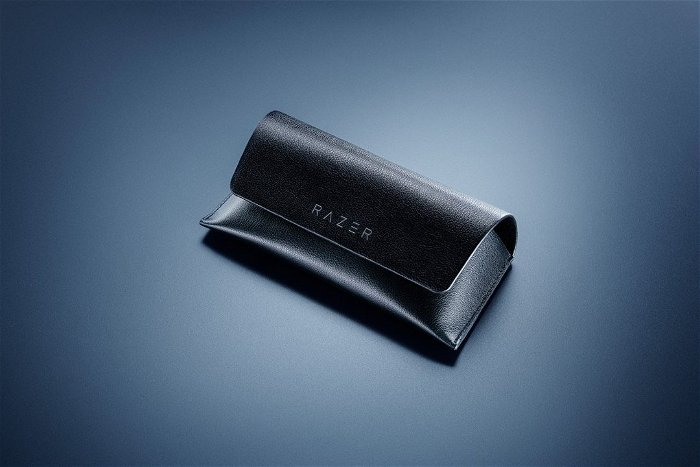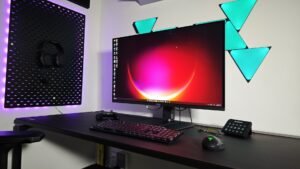If you had told me five years ago I would be looking at eyewear-headphone hybrids and enjoying the experience I wouldn’t have believed you, but here we are. While not a new sector, the Razer Anzu delivers a new set of eyewear-headphone hybrids that bring blue light protection and a stylish design that works and looks better than expected, even if there were a few snags.
Before we go any further, let us be clear, while this may seem like a crazy concept, this is not that new a thing. Bose have had audio glasses for a while, and last year Amazon released the more affordable Echo Frames that delivered Echo on your face. But Razer are the first that combine the joys of audio eyewear with gaming features to set them apart from the rest of the pack.
Looking at the Razer Anzu, at first glance they feel like your typical “Ray-Ban” style glasses. The thick plastic frames feel modern yet timeless, with the Razer branding being subtle. It is not until you open them up you will see how the tech is integrated into the eye wear.

The arms of the glasses each house the audio modules, making them much chunkier than your typical set of plastic glasses. While it is less noticeable when you first put on the frames, at least in my case, I found they are a bit more bothersome to wear over longer periods of time. The arms are also where you will find the charging connectors, and since this is 2021, they are also where you will find the touch sensitive audio controls for ‘easy’ operation.
I found the small/medium size of the Anzu fit well, but Razer also offers a large size should you feel you need it. They also offer two different frame styles, the rectangular “Ray-Ban” looking frame, and a rounder frame for people that want to ooze hipster vibes. The Anzu also boasts IPX4, a great and needed feature for something you need to wear and potentially could get rained on while out and about.
As with most modern Bluetooth headphone options, there are a few ways to connect these glasses to your phone, and both worked in our testing. The simple method of pairing like any other set of wireless headphones, or by jumping into the Razer mobile app and setting things up that way. I personally started off with the simple process of just pairing things to my phone and heading out the door, if you want any touch control customization, the Razer Anzu app is your only choice.

One of my biggest gripes with the Anzu rests with the touch controls. While it seems this is where all modern audio devices are headed, I have never managed to master the art of telling my electronics what to do by touch. The Razer Anzu is set up to recognize different presses, such as single press, double tap, triple tap, long press. While this may sound simple in theory, I had issues getting them to register the right action with it resulting in the wrong thing taking place, or reaching for the phone to resolve the issue. They also seemed to enjoy randomly acting as if I was pressing them as I walked about my day. Not common enough to be a deal breaker, but frequent enough to get frustrating.
When you get the hang Anzu’s touch commands the glasses manage to do what they were supposed to. Double pressing to skip to the next song and the press combo for Game Mode all felt good – when they worked. And despite looking like you are out of a 1950’s spy movie by constantly tapping on your specs, it was nice to not reach for my phone while going about my day.
But this also brings up the Anzu low-latency Game Mode that is supposed to make gaming with the glasses a much more responsive experience. Boasting “industry-leading 60ms” response times, I was eager to see how they fared. Booting up Diablo Immortal on my OnePlus 9 Pro, I decided to see how it stacked up. Granted, Diablo Immortal is not a game that needs audio cues to judge, but the fast action and plethora of sounds put the Anzu through it’s paces nonetheless.

With Game Mode enabled, the audio synced well with the on screen action for the most part. It did not feel as responsive as a PC game with dedicated headphones, but it was more than serviceable with it feeling efficient enough for most on-the-go gamers. With game mode off, that is when everything felt sluggish. There was a noticeable delay from an action to the audio cue, and I very quickly had to quit the game as it made the experience jarring. This is coming from a PC and console gamer, so to have that level of delay is not something I could put up with. So, if you game, ensure game mode is turned on with the Anzu, or you may be in for a frustrating experience.
With that out of the way, once I actually used the Anzu to enjoy music, podcasts and other audio, I enjoyed my experience. Granted, the audio quality out of the open-ear speaker design is not the best. With no sound isolation the audio does lack fullness and can feel hollow. It is also worth noting that if you like your music loud, expect everyone around in a 6-feet area to notice you. But with the way they are designed you may need to turn the volume up, since the Anzu can be a bit quiet.
The Razer app offers a selection of EQ presets, and they all do what they need to do, but as I mentioned earlier, open-ear speakers are limited in fidelity. While the app does offer “Enhanced Clarity” and “Treble Boost”, don’t expect it to drastically improve the sound, though it is nice to have the options to tweak things when needed. Sadly, there are no options for Bass Boost currently.

Another special feature with the Razer Anzu is the included 35 percent blue-light filtering lenses in the box to allow for computer or gaming use while reducing eye strain. The argument can be made that blue light is harmful, and I know I swear by my GUNNAR frames when at my desk, and these are no different. They are only 35 percent, so don’t expect major differences when using them, but while testing I found my eyes were less tired after around 4-5 hours on a screen. I did find the Anzu got uncomfortable with this length of use, but that could differ depending on how they fit and how used to glasses you may be.
On the battery life front, the Anzu boasts around five hours, and I found this to be pretty on the mark. After a workday, they were on their last legs needing to be charged, but I managed to stretch them to around 4.5 hours. This could vary based on use, but this included basic streaming, podcasts and music, so I was overall satisfied with the results. The charging method of connecting both arms took a bit to get used to, but once I sorted through the process, it worked as expected.
While I am new to the eyewear-headphone market, and it is hard to say what the “best” is so far, the Anzu feels well-thought-out and delivers fantastic value for the money. It brings gaming centric features such as low-latency audio and blue-light filtering lenses, and looks stylish enough to be seen in, they sit as a great option. They will not replace your gaming headphones or your other earbuds, but work as a good compliment especially if you demand open-ear designs or just want on the go headphones with some gaming chops.





